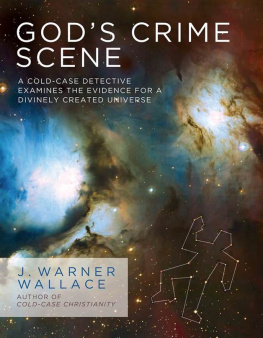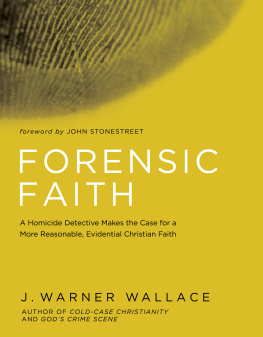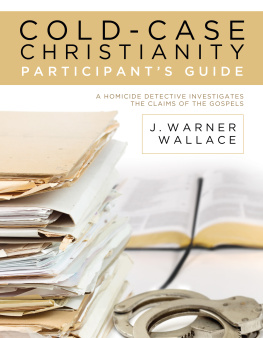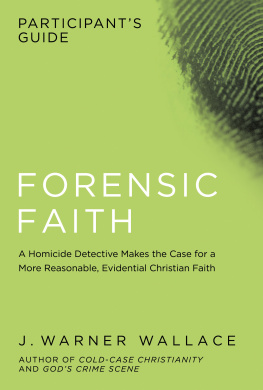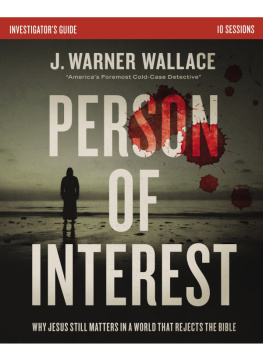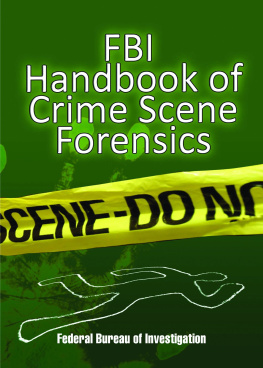All science, even the divine science, is a sublime detective story. Only it is not set to detect why a man is dead; but the darker secret of why he is alive.
G. K. Chesterton
CONTENTS
Has Someone Else Been in This Room
In the Beginning
Was the Universe an Inside Job?
Tampering with the Evidence
Who Is Responsible?
The Origin of Life
Does the Text Require an Author?
Signs of Design
Is there Evidence of an Artist?
Our Experience of Consciousness
Are We More Than Matter?
Free Will or Full Wiring
Are Real Choices Even Possible?
Law and Order
Is Morality More Than an Opinion?
The Evidence of Evil
Can God and Evil Coexist?
Make a Decision and Make It Now
The Secondary Investigation
The Expert Witness
The Investigative Notes
SPECIAL THANKS
I am deeply grateful for several co-laborers who contributed to Gods Crime Scene . Some were expert witnesses who corroborated the facts; others were expert communicators who helped shape the message. Thanks to my good friend and ministry partner, Frank Turek (www.crossexamined.org), Michael Behe (www.discovery.org), Amy Hall (www.str.org), Sean McDowell (www.seanmcdowell.org), Hank Hanegraaff and Stephen Ross (www.equip.org), Richard Howe (www.richardghowe.com), Jeff Zweerink (www.reasons.org), Sarah Salviander (www.as.utexas.edu), and my editor, Rob Suggs. Thanks also to the busy culture shapers and investigators who were willing to read this book and offer an endorsement. I continue to be humbled by the men and women who have taken the time to support my work.
This book is dedicated to my father, James David Wallace. Dad, I hope to persuade you to read my books and consider the case for God and the case for Christ. You taught me to be a good investigator and led me to law enforcement as a career. Now its my turn to lead you to the truth.
Opening Statement
HAS SOMEONE ELSE BEEN IN THIS ROOM?
Please, please find out what happened to him!
Cindy Matthews was shaking uncontrollably, tugging at her hands and shifting her weight anxiously from one foot to the other. She had just discovered her father, Richard, was dead, the apparent victim of a gunshot wound.
Our team was called to the location after the patrol officers responded to Cindys 911 call. The responding officers found her on the front porch of her fathers house, frantic and frustrated. She was unable to enter the locked residence but could see her father through the large living room window. He was unquestionably dead.
The top of Richards head was open and exposed; he appeared to have a gunshot entry wound under his chin. He was lying with both arms outstretched, the remaining portion of his head tilted back against his worn recliner. His legs were straight; he was swollen and discolored. A handgun lay on the floor as the television blared in the background.
I had been on our homicide team for only a short time. Standing to the side, my call-out bag slung over my shoulder, I was the new guy, and to make matters worse, I was fifteen years junior to everyone else on the team. I was here to learn, conduct a few interviews, and fetch coffee for the guys who would ultimately handle this case.
My senior partner, Alan Jeffries, was the last to arrive on scene; the rest of us dared not enter without him. He walked up to the porch of the residence and barked orders at several patrol officers, making sure they secured the crime scene and warning them to prevent looky-loos from contaminating the evidence. He was characteristically terse and short tempered.
Newbie! Get on up here! he snapped.
On the way, I replied, turning briefly to finish my interview with Cindy.
Cindy couldnt stop the tears. I tried to reach Dad on the phone on Monday, she told me. He never answered. By Tuesday night I was starting to get concerned, but I couldnt come over until today because I had to take care of my son last night. Hes been sick all week. I know hes dead, but I need to know if he killed himself.
Why would you think such a thing? I asked. Did your father give you any reason to believe he was suicidal?
Well, he was recently diagnosed with liver cancer. I know he was a strong man, but I also know he was discouraged about the diagnosis. Cindy stopped crying and took a deep breath. I hate to think my father would kill himself. Please, please find out what happened to him!
Every homicide case begins as a simple death investigation. When a dead body is discovered, detectives must investigate the evidence to determine the most reasonable explanation. Did the deceased die naturally? Did he suffer some kind of accident? Did he commit suicide? Was he murdered? These are the four possible explanations at any death scene. Homicide detectives are concerned only with the last one.
I considered these four possibilities for a moment as I walked toward Richards front door. Locked in his house, Richard lay motionless in a sealed room. Of the four explanations, the first three did not require the involvement of anyone other than Richard. If his death was an accident , the result of some natural cause , or the result of a suicide , all the evidence we might find related to Richards passing would ultimately come from the very room where he died. Without evidence of an intruder , this death was likely to be the result of natural causes, an accident, or a suicide.
If Richards death was a homicide, however, our team would likely find evidence someone other than Richard had been in his home. One simple strategy in cases like this, therefore, is to ask a foundational question: Can I account for all the evidence in this room by staying in the room ?
We waited for the CSI investigators to photograph the porch and front door of the residence. Alan then assisted the officers as they carefully forced open the door. Our homicide team gathered for entry and immediately recognized the overwhelming smell of death; Richard had been in this condition for several days.
I scanned the scene with my inexperienced eyes and tried to categorize this death in my own mind. It was clearly not a natural death. Nor did it appear to be an accident. The location of the gunshot entry wound (under Richards chin) seemed to be consistent with suicide, and Cindy had told us Richard had been discouraged about his recent cancer diagnosis.
In addition, a six-shot .38-caliber handgun was lying on the floor. Handguns used in suicides are often discovered on the floor near the victims body. Most importantly, I saw no evidence anyone other than Richard had been in the room. As a new detective, I suspected he had committed suicide.
Be very careful here, newbie. This is a homicide. Alan stuck out an arm to slow my entry. As usual, he made a quick assessment and proclamation, and as usual, the team responded as though Alan knew what he was talking about.
I held my tongue on my observations, but Bill Shaw, one of my partners, was less cautious. What makes you so sure? he said. His tone suggested he was challenging Alans bravado more than his conclusion.
Alan was unflustered. Take a look at the gunshot wound. Left side of the neck under the chin, right? But his coffee cup is on the table to his right. So are his reading glasses. This guys right-handed, but the wound is on his left side.

